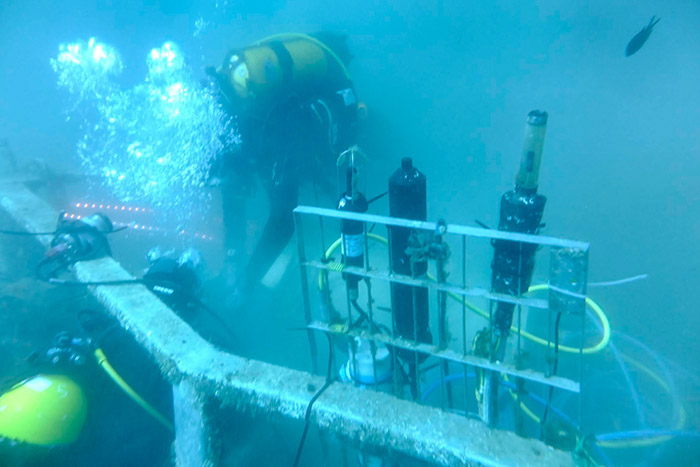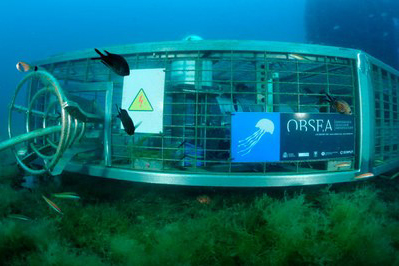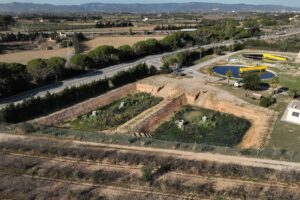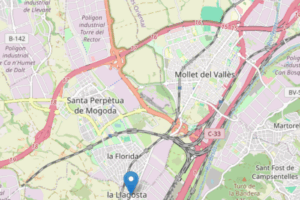
A new generation of batteries to move towards greener mobility
September 30, 2021
Modelling of mobility in Barcelona Metropolitan Region to assess the urban master plan
October 18, 2021The underwater observatory OBSEA, operated by the Development Center of Remote Acquisition and Information Processing Systems (SARTI) of the UPC, is participating in SILENCIO, an initiative of the Centro Tecnológico del Mar-Fundación Cetmar, dependent on the Ministry of the Sea of the Government of Galícia, which aims to contribute to the good environmental state of the marine environment and reduce the acoustic impact and the carbon footprint of fishing activity.
SILENCIO aims to establish the bases for developing more sustainable fishing and seafood harvesting activity with less acoustic impact. The project will identify the main sources of underwater noise in the Galician Ries Baixes, both of human origin due to the activities that humans carry out in the sea and natural origin. The underwater observatory of the UPC has incorporated since July a hydrophone that is the twin of the one installed in Cortegada, Galicia.

The OBSEA hydrophone will record underground noise in the area of Vilanova i la Geltrú and will focus on the identification of fishing activities and cetaceans passing through the area, like the hydrophone in the Ries Baixes project. An algorithm developed by the Multimedia Technology Group at the University of Vigo will be applied to both records to automatically detect sources of noise, so as to evaluate the transferability of this tool to other records. The objective is to be able to automatically identify the noise from boats and cetaceans and display these on a viewer that has been developed as part of the project and that will be presented in the next few months.
The results obtained from monitoring underwater noise will enable solutions to be proposed to minimise the environmental impact of fishing activity. Specifically, the feasibility of incorporating electric propulsion in small fishing vessels will be assessed, to reduce the carbon footprint in the sector and the noise pollution that it generates. For this reason, the fishing sector is involved in the project and committed to searching for solutions so that the sector can become environmentally sustainable, socially responsible and economically viable.

About OBSEA
OBSEA is an underwater observation laboratory situated on the seabed four kilometres from the coast. It is connected to land via a mixed cable for power and communications through which it provides energy for the scientific instruments. The instruments transmit information in real time on many parameters in the marine environment and has a broadband communication link.
The observatory has a seismometer, a video camera and various sensors of temperature, salinity, conductivity and pressure, with a broadband hydrophone, a current profiler and a pH sensor. It also has a buoy 40 metres from the observatory that functions as a platform to take oceanography and environmental measurements. It is also equipped with a meteorological station with GPS that measures the direction and speed of the wind, atmospheric pressure and air temperature, among other parameters. In the land station, situated in the SARTI facilities in Vilanova i la Geltrú, is another meteorological station that regularly measures and records various meteorological variables.
Technology
You want to know more?
Related Projects
- The company Trace ID and the group Twin Investors, in collaboration with the Textile Technology research group (TECTEX), which is part of the Institute of Textile Research and Industrial Cooperation of Terrassa (INTEXTER) at the Universitat Politècnica de Catalunya - BarcelonaTech (UPC), are developing electronic devices to identify, monitor, and study the traceability of the products in which they are embedded.
- The Hydrogeology Group (GHS) at the Universitat Politècnica de Catalunya - BarcelonaTech (UPC) is participating in the LIFE REMAR project to develop an innovative and sustainable solution for the reuse of treated wastewater through infiltration, with the aim of increasing the availability of freshwater resources and improving the state of ecosystems.
- A team from the Environment Centre Laboratory (LCMA) of the Universitat Politècnica de Catalunya - BarcelonaTech (UPC) is taking part in a study commissioned by the city councils of la Llagosta, Mollet and Santa Perpètua (in Vallès Occidental), with the main objective of identifying the impact of industrial plants on the generation of unpleasant odours and continuously monitoring air quality in these municipalities.
- A multidisciplinary team of researchers from the Research Group in Smart and Sustainable Resources and Industries (RIIS), the Sustainable Mining Research Group (GREMS), and the Construction Materials and Roads (MATCAR) group at the Universitat Politècnica de Catalunya – BarcelonaTech (UPC) is leading the VALORFIN project. The aim is to develop a technological solution for the valorisation of the fine fraction of construction and demolition waste (CDW), transforming it into new low-CO₂-emission cementitious materials, while also reducing the presence of hazardous materials in this waste.




